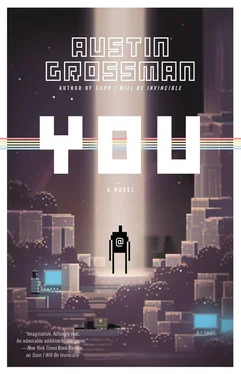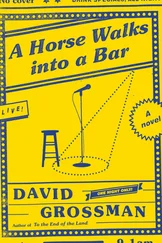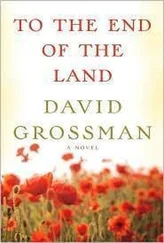“You got through changing terrain, right? Placing objects?”
I nodded. I hadn’t, quite, but I’d decided already to stop admitting things like that, to just add them to the list of things I’d figure out later. I had to just keep assuming I was smart enough for this job.
“That’s the 2-D texture library, object library, terrain presets, lighting…” She toggled through a series of windows full of tiny icons that looked like candies on a tray.
“There’s really no manual for any of this?” I asked.
“I never have time, and the spec is always changing anyway.” Did she write all this?
“This is the creature library. Just select one, then click on the 2-D map to place it. Shift-click to bring up its behaviors. Scripting, conversation, patrol routes, starting attitude.” She clicked, and clicked again faster than I could follow. A tiny dragon appeared, frozen in the 3-D window; a corresponding dot appeared in the map window.
“So is that…” I started.
“It’s a bad guy. Okay so far?”
“Sure,” I lied.
“So viewing options now. You can cycle through the four versions of the world.” She backed the viewpoint up into the sky, then whip-panned to focus on a small fort in the middle of a forest, a single round tower, and tapped the space bar.
“Wireframe.” The screen instantly darkened to a black void where the tower stood, now revealed as an octagonal tube drawn in precise, glowing straight lines, triangular and trapezoidal facets in a night-black void. “Like in Battlezone . Back when you were gaming, probably the first 3-D game you saw.”
She tapped again. “Unshaded polygons.” The glowing lattice kept its shape but became an opaque crystal formation, sides now solid, a world of pastel-colored jewels that shone in a hard vacuum. Atmospheric haze is a high-tech extra.
Another tap of the space bar and the blank jewel facets filled with drawn-in detail. The tower walls were now painted to look like stonework, expertly shaded to indicate bumps and ridges.
“Textured polygon. Like a trompe l’oeil painting, if you took that in college. Whatever you did in college.”
“English.”
“Wow,” she said, toneless. “I’m going to zoom in a little—when we get closer it swaps in a high-res texture to give it more detail,” she said. As the camera moved in the stones of the tower blossomed with moss, cracks, crumbling mortar.
“Beautiful,” I said.
“Smoke and mirrors. It looks real but there’s a million little tricks holding it together,” she said. I couldn’t tell from her tone whether she was proud of the illusion of reality or contemptuous of the cheap theatrics. “Okay, now last year’s big hack—textured polygons, but with lighting.”
A final tap of the space bar and the tower was brushed with shades of darkness that gave it definition and, somehow, the impression of weight. The light came from just above the horizon, a sunset, and the hills beyond the tower faded away into dimness.
“Didn’t it just get darker?”
“Lighting isn’t about making it brighter, it’s figuring out where the shadows do and don’t fall. It’s easy to just light everything—you’re just not checking for darkness. What’s tricky is looking where the light source is and when it’s blocked.”
In the upper right corner of the screen, I noticed the letters FPS, followed by a flickering number. It bounced around between thirty and forty, with occasional jumps into the sixties. When Lisa added the lighting effects, the number tumbled into a single digit and turned red, and the view seemed to stutter instead of panning smoothly.
“What’s FPS?” I asked.
“Frames per second,” she said after a moment. “How many times the view updates every second. When it gets below thirty, everything starts to look jerky.”
“Like it’s doing now?” I asked.
“Yeah. It’s having to draw too many lit polygons. It has to do other stuff, like update positions of objects and play sounds and do AI calculations and all that stuff, too, but graphics are always the big drain. It’s all about getting those polys up on-screen to make everything detailed and pretty. The more polys you draw the better it looks, but then the frame rate slows down. Fewer polys, higher frame rate.”
“So who’s putting all those polygons up there?” I said, intuiting the answer.
“You are. You’re a designer, you build the world they have to draw every second. So you know when you’re in a meeting and there’s a guy who’s just looking at you with this twitchy, barely controlled hatred every time you open your mouth? That’s a graphics programmer. Every bright idea you have is putting more polygons on-screen and making his job harder. Every time that number on the screen goes below thirty, everyone can see that his code is slow and therefore he is not smart.”
“Good to know.”
“That guy’s entire job is to keep that frames-per-second number above thirty and green. Every time you put in too many trees, or make a room too large, or put five dragons in the same room, it’s going to turn red.”
“Then if I’m a game designer, what’s my whole job?”
“I don’t really play games, so I don’t know,” she said. “From what I gather, it’s to keep adding stuff to the world until that number gets to exactly thirty-one.”
“I thought it was to make the game fun.”
“I don’t know what that means, though,” she said. She was watching me carefully as she spoke. As if maybe she was hoping I knew a secret everyone else had forgotten.
Isat down at my desk and tried to remember everything Lisa did. Now that I knew about frames per second, I could see the number drop every time I made a room bigger or more complicated, the point of view lurching like a stick-shift car with a novice driver. That’s why everything felt claustrophobic, because every cubic foot of space meant more polygons. That’s why the player was stuck in underground corridors all the time—it was just the easiest thing to draw.
I browsed around the network directories, looking for something to do, snooping at folders. There was an Art/Assets server with gigabytes of images and 3-D models, thousands of them, and a little viewer that would show the model on the screen by itself, hanging in a starry void. I chose a file at random and opened it: a bird-headed knight on horseback. The next, a black London taxi. The third, a silver-metal rifle with its circuitry burned out. I wondered who the bird’s-head knight was. The files went on and on, thousands of them, as if a whole library full of weird stories had been shaken and these were the random objects that fell out. A wooden cross; a china teapot; a sarcophagus. I’d stumbled into the great storehouse of their toy multiverse.
I clicked and a 10′ by 10′ by 10′ cube appeared, lit as if by a candle flame. It was textured as the default plain stone wall. Click and click and you’re digging out a corridor, rooms, cube by cube. Paint on textures, stone or wood or dirt or lava. You can build what you like, nothing weighs anything and it’s all infinitely strong. You can build pillars of dirt, metal, lava, water. I built a few rooms and corridors, dropped in a few monster spawners, treasure, and the rest, then flipped into game mode to see what it felt like.
Back in the game, I could see how this could get frightening. It was one thing to see a map of the place. It was another to be fifty feet belowground, down there in the dark, in a world silent except for distant running water, and… footsteps. A figure emerged from the darkness at the end of the corridor. A walking skeleton, animated by who knew what necromantic fires, ambled toward me. I stepped to the left to let it pass, keeping my eyes on it. To conserve polygons, it was built like a paper doll, a picture of a skeleton mounted on a single plane that slid around the dungeon shuffling its feet, pretending to walk. I felt bad for it. It wanted so badly to look like it was in 3-D. Up close I could see how low-resolution it was, too, just a bunch of pixels in jagged lines, like the side of an Aztec pyramid, just a graphic pretending to be a skeleton.
Читать дальше





![Ally Carter - [Gallagher Girls 01] I'd Tell You I Love You But Then I'd Have to Kill You](/books/262179/ally-carter-gallagher-girls-01-i-d-tell-you-i-lo-thumb.webp)






